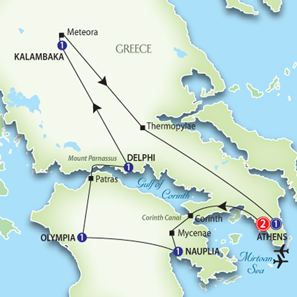

   |
 Greece 2009! |
Three Notes: * Details will be added during the summer - just need to get the basics up first. * I will be linking to a wiki page soon so that comments & corrections can be posted & discussed by all. * Please email me or post on the wiki when it is up! |
A "Think About": Where did the early Americans live when Ancient Greece was flourishing? (click above or see below) |

 Maps from our tour company site - http://www.trafalgar.com |
The Islands: |
|
|
|
||

|
|
|
|
||||||||||||||||||
|
Temple of Zeus
|
|||||||||
|
|
||||||||||||||||||
|
|
|||||||||||||||||||||||||
Nauplia & Mycenae
to Olympia
Thursday, July 2nd
|
Mycenae:
|
||||||||||||||||||
|
|
||||||||||||||||||||||||||||||||||
|
|
|||||||||||||||||||||||||||||||||||||||||||||||
|
Driving over the Pourmaraki Pass, though Thermopylae to Kalambaka We had the opportunity on our Fourth of July drive to stop at Thermopylae & the memorials for the fallen Greek heroes. It was a fitting day - freedom & its cost - in all ways - for many people & civilizarions.
|
||||||||||
|
|
We stopped in a little town where Peter the Pelican lives on top of this church. The locals help him rebuild his nest very year. His wife and babies were in the nest when we passed by. |
|||||||||
|
We stayed the night in Kalambaka, the northern most city on our land adventure. The next morning, we saw the monasteries at Meteora and headed to Athens, to finish our land tour and start our island cruise. |
||||||||||
|
|
||||||||||
|
|
|||||||||||||||||
|
|
||||||||||||||||||
|
|
|||||||||||||||||||||||||||||||||||||||
|
||||||||||||||||||||||||||||||||
|
|
||||||||||||||||||||||||
|
The island of Crete is the fourth
largest island in the Mediterranean & the largest island in Greece.
Heraklion (or Iraklio) is the largest modern city. |
||||||||||||||||||||||||
|
||||||||||||||||||||||||
|
|
||||||||||||||||||||||||
|
Thira or Santorini |
||||||||||||||||||||||||
|
||||||||||||||||||||||||
|
After leaving Santorini the Aegean Pearl sailed to Piraeus, over a distance of 131 nautical miles. We returned to Athens & had a long afternoon to finish exploring the city and ruins. |
||||||||||||||||
|
|
|
|||||||||||||||
|
The Tower of the Winds
(or the Horologion of
Andronikos of Kyrrhos) is an eight
sided tower built to serve three functions: 1) on the inside was a
water clock (driven by the waters coming down from the Acropolis), 2)
on the outside was a sundial, & 3) on the top was a triton weather
vane to point to the eight wind directions shown on the carvings of
each side - Boreas (N),
Kaikias (NE),
Eurus (E),
Apeliotes (SE),
Notus (S),
Livas (SW),
Zephyrus (W), and
Skiron (NW).
It is thought to date to around 150 BC., is roughly 36 feet high, and has a diameter of 24
feet. |
Hadrian's Library was
built by the Roman Emperor Hadrian in 132 AD. It was a large area that
not only held scrolls, but gardens, ponds, art works, lecture halls,
and walking areas. It was one of the cultural center for the people of
Athens |
|||||||||||||||
|
|
||||||||||||||||
|
||||||||||||||||
|
Below are a series of pictures and
information from one of the museums in Athens. |
||||||||||||||||
|
|
|
|||||||||||||||
| From a sign at the museum: "Ostracism was a unique type of voting intended as a means of protecting the city against aspirant to despotic power. The result of the ostracism vote was valid only if there were 6,000 [citizens] present. Each voter scratched or painted on a potsherd the name of the man he thought most undesirable. The "candidate" with the greatest number of votes against him was obliged to withdraw from Athens for ten years. Ostracism was decreed by Kleisthenes and was used through most of the 5th century BC. In many cases it came to be used as a tactical maneuver between rival politicians." | ||||||||||||||||
|
|
||||||||||||||||
|
||||||||||||||||
|
|
||||||||||||||||
|
|
||||||||||||||||
|
Did we mention the heat? Oh yes - it was hot the entire time! In the modern Agora of Athens, there were wonderful little street cafes where one could sit and get a gyro and beer. To our great delight, many of them had fans with misting tubes attached. Fine sprays of water would sweep over you with a light fan breeze to cool you off. K&K loved it too! Time for our last beer then back
to the hotel for an early night & an early wake up call. |
||||||||||||||||
|
We woke up early and headed to the airport. The trip home was long, but uneventful. Another four hour layover in Philly and off to Roanoke. It was good to be home. Within a week we would be picking
up our two eight week old Shih Tzu puppies. |
Room III: Early Archaic Period. The star attraction here is a pair of famous Archaic (6th century BC) statues, depicting either the Argive twins Cleobis and Biton or the Dioscuri. They stand 7 feet (2.16m) tall. Also here, and also dating from the 6th century, are painted terracotta fragments and five metopes from the Sikyonian monopteros, a round building with an open roof. The metopes are damaged but still retain some traces of paint. They are thought to depict: the Argonauts; Zeus' abduction of Europa; Castor and Polydeuces stealing the Arcadian cattle; hunting of the Calydonian Bear; the quest for the Golden Fleece. http://www.sacred-destinations.com/greece/delphi-museum